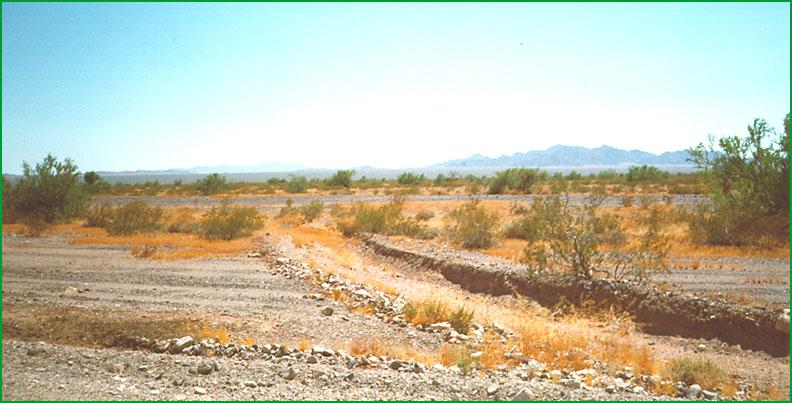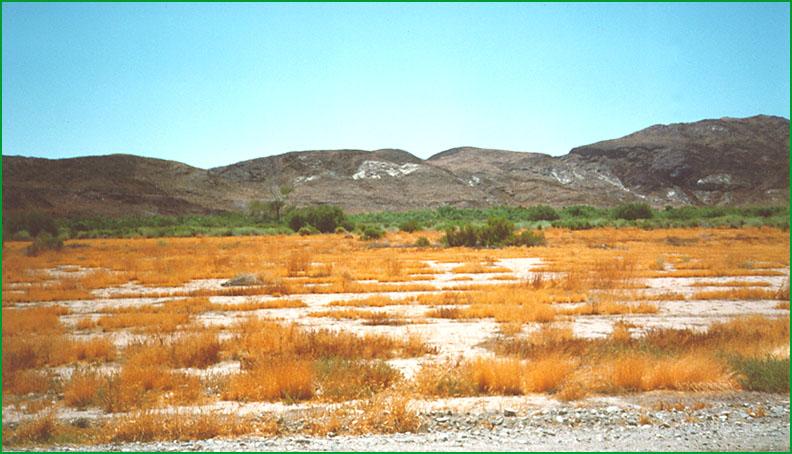 | Cadiz - Vidal Valleys -Palen - Riverside Mountains |
Vidal Valley area Ś Matthew Miles |
Big Maria Mountains, looking west from Colorado River area (322Bd) Ś Matthew Miles |
Subsection 322Ba
Cadiz - Vidal Valleys
This subsection includes mostly alluvial fans and basin floors in Cadiz, Palen, Rice, and Vidal Valleys and the lower part of Ward Valley. It includes Iron Mountain and hills that stick up through the alluvial plains in the valleys. The climate is very hot and arid climate. MLRA 30g.
Lithology and Stratigraphy. Quaternary alluvial, lacustrine, and eolian deposits predominate in this subsection. The mountains and hills are mostly Mesozoic granitic and Pre-Cenozoic and Precambrian granitic and metamorphic rocks.
Geomorphology. This subsection is on very gently to moderately sloping alluvial fans, nearly level basin floors and dry lake beds, steep mountains, and moderately steep hills. Palen and Ward Valleys are aligned north-south. The other Valleys are in a depression that extends from the south end of Silurian Valley southeast to the Colorado River. There are two large dry lake beds; Cadiz Lake in Cadiz Valley and Danby Lake in Ward Valley. The elevation ranges from about 400 to 1800 feet on alluvial plains up to 3350 feet in the Iron Mountains. Fluvial erosion and deposition and eolian deflation and deposition are the main geomorphic processes, plus mass wasting in the Iron Mountains.
Soils. The soils are mostly Lithic Torriorthents on mountains and hills. They are mostly Typic Torrifluvents, Typic Torripsamments, and Typic Torriorthents on younger fans and basin-fill and mostly Typic Calciorthids and Typic Haplargids on older fans. There are Typic Torripsamments in eolian sand. The soils are well drained, except on poorly drained playas. There are Salorthids on poorly drained playas lacking vascular plants. Soil temperature regimes are mostly hyperthermic, and thermic in the Iron Mountains. Soil moisture regimes are aridic.
Vegetation. The predominant natural plant communities are Creosote bush series and Creosote bush - white bursage series. Black bush series occurs at higher elevations in the Iron Mountains. Mixed saltbush series is common and Mesquite series occurs on basin floors.
Characteristic series by lifeform include:
Grasslands: Alkali sacaton series, Desert sand - verbena series, Indian ricegrass series, Pickleweed series, Saltgrass series.
Shrublands: Allscale series, Black bush series, Bush seepweed series, Catclaw acacia series, Brittlebush series, Brittlebush - white bursage series, Creosote bush series, Creosote bush - white bursage series, Desert-holly series, Fourwing saltbush series, Iodine bush series, Mixed saltbush series, Ocotillo series, Teddy-bear cholla series, White bursage series.
Forests and woodlands: Blue palo verde - ironwood - smoke tree series, Foothill palo verde - saguaro series, Mesquite series.
Climate. The mean annual precipitation is about 3 to 5 inches. It is all rain. Mean annual temperature is about 65░ to 75░ F. The mean freeze-free period is about 275 to 325 days.
Surface Water. Runoff is rapid from mountains and alluvial fans and slow from basin-fill. The drainage from Palen and Cadiz Valleys is to Cadiz Lake, from Ward Valley it is to Danby Lake, and from Vidal and at least part of Rice Valley it is to the Colorado River. Streams have no water in some years and are dry most of each year in other years. There is temporary ponding on playas, or dry lake beds, in some years
Subsection 322Bb
Palen - Riverside Mountains
This subsection includes six small mountain ranges, each surrounded by alluvial plain, that are close together. They are between Ward and Rice Valleys on the north, the Colorado River on the east, Chuckawalla and Palo Verde valleys on the south, and Palen valley on the west. The subsection has a hot to very hot arid climate. MLRA 30g.
Lithology and Stratigraphy. The bedrock in this subsection is mainly Mesozoic granitic, Pre-Cretaceous metavolcanic, Paleozoic marine sedimentary, and Precambrian igneous and metamorphic rocks.
Geomorphology. This subsection is on steep mountains. The mountain ranges are somewhat elongated, with trends ranging from north-south to northwest. The elevation ranges from about 400 feet adjacent to the Colorado River up to 2252 feet in the East Riverside and 2667 feet in the West Riverside Mountains, 2870 feet in the Big Maria Mountains, 2835 feet in the McCoy Mountains, 3043 in the Little Maria Mountains, 3623 feet in the Palen Mountains, and 4353 feet in the Granite Mountains. Mass wasting and fluvial erosion are the main geomorphic processes.
Soils. The soils are mostly Lithic Torriorthents and Lithic Camborthids. Soils on alluvial fans surrounding the mountains are mostly Typic subgroups of Torriorthents, Calciorthids, and Haplargids. Soil temperature regimes are mostly thermic, and some hyperthermic; and soil moisture regimes are aridic.
Vegetation. The predominant natural plant community is Creosote bush - white bursage series. Blue paloverde - ironwood - smoke tree series occurs in washes.
Characteristic series by lifeform include:
Grasslands: Big galleta series.
Shrublands: Brittlebush series, Brittlebush - white bursage series, Catclaw acacia series, Creosote bush series, Creosote bush - white bursage series, Desert-holly series, Ocotillo series, Teddy-bear cholla series, White bursage series.
Forests and woodlands: Blue palo verde - ironwood - smoketree series.
Climate. The mean annual precipitation is about 3 to 5 inches. It is all rain. Mean annual temperature is about 60░ to 75░ F. The mean freeze-free period is about 250 to 300 days.
Surface Water. Runoff is rapid. Streams are dry most of each year, and dry throughout some years

